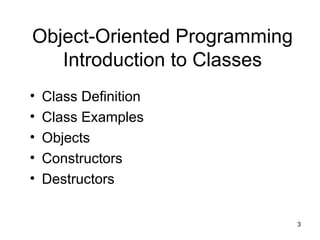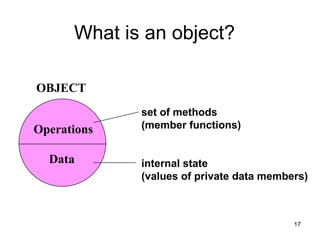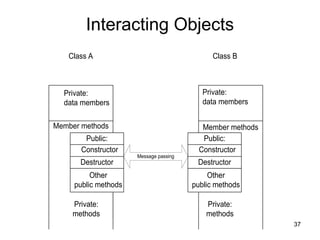Object Oriented Programming Examples with explanation
- 1. 1 • A pointer variable is a variable whose value is the address of a location in memory int x; x = 5; int* ptr1; ptr1 = &x; int* ptr2; ptr2 = ptr1; *ptr1 = 6; cout << ptr1 << endl; cout << *ptr2 << endl; Review: Pointers & Dynamic Data int* ptr3; ptr3 = new int; *ptr3 = 5; delete ptr3; ptr3 = NULL; int *ptr4; ptr4 = new int[5]; ptr4[0] = 100; ptr4[4] = 123; delete [] ptr4; ptr4 = NULL;
- 2. 2 void increment(int b1, int &b2, int *b3) { b1 += 2; b2 += 2 *b3 += 2; } Review: Reference Types • Reference Types – Alias for another variable – Must be initialized when declared – Are primarily used as function parameters int main (void){ int a1 = 5, a2 = 10; int *a3 = new int; *a3 = 15; int &a4 = a3; cout << a1 << a2 << a3 << endl; increment(a1, a2, a3); cout << a1 << a2 << a3 << endl; delete a3; a3 = NULL; return 0; }
- 3. 3 Object-Oriented Programming Introduction to Classes • Class Definition • Class Examples • Objects • Constructors • Destructors
- 4. 4 Class • The class is the cornerstone of C++ – It makes possible encapsulation, data hiding and inheritance • Type – Concrete representation of a concept • Eg. float with operations like -, *, + (math real numbers) • Class – A user defined type – Consists of both data and methods – Defines properties and behavior of that type • Advantages – Types matching program concepts • Game Program (Explosion type) – Concise program – Code analysis easy – Compiler can detect illegal uses of types • Data Abstraction – Separate the implementation details from its essential properties
- 5. 5 class Rectangle { private: int width; int length; public: void set(int w, int l); int area(); }; Classes & Objects Rectangle r1; Rectangle r2; Rectangle r3; …… int a; Objects: Instance of a class
- 6. 6 Define a Class Type class class_name { permission_label: member; permission_label: member; ... }; class Rectangle { private: int width; int length; public: void set(int w, int l); int area(); }; Body Header
- 7. 7 Class Definition Data Members • Can be of any type, built-in or user-defined • non-static data member – Each class object has its own copy • static data member – Acts as a global variable – One copy per class type, e.g. counter
- 8. 8 class Rectangle { private: int width; int length; static int count; public: void set(int w, int l); int area(); } Static Data Member Rectangle r1; Rectangle r2; Rectangle r3; width length width length width length r1 r3 r2 count
- 9. 9 Class Definition Member Functions • Used to – access the values of the data members (accessor) – perform operations on the data members (implementor) • Are declared inside the class body • Their definition can be placed inside the class body, or outside the class body • Can access both public and private members of the class • Can be referred to using dot or arrow member access operator
- 10. 10 Define a Member Function class Rectangle { private: int width, length; public: void set (int w, int l); int area() {return width*length; } }; void Rectangle :: set (int w, int l) { width = w; length = l; } inline class name member function name scope operator r1.set(5,8); rp->set(8,10);
- 11. 11 • const member function – declaration • return_type func_name (para_list) const; – definition • return_type func_name (para_list) const { … } • return_type class_name :: func_name (para_list) const { … } – Makes no modification about the data members (safe function) – It is illegal for a const member function to modify a class data member Class Definition Member Functions
- 12. 12 Const Member Function class Time { private : int hrs, mins, secs ; public : void Write ( ) const ; } ; void Time :: Write( ) const { cout <<hrs << “:” << mins << “:” << secs << endl; } function declaration function definition
- 13. 13 • Information hiding – To prevent the internal representation from direct access from outside the class • Access Specifiers – public • may be accessible from anywhere within a program – private • may be accessed only by the member functions, and friends of this class – protected • acts as public for derived classes • behaves as private for the rest of the program Class Definition - Access Control
- 14. 14 class Time Specification class Time { public : void Set ( int hours , int minutes , int seconds ) ; void Increment ( ) ; void Write ( ) const ; Time ( int initHrs, int initMins, int initSecs ) ; // constructor Time ( ) ; // default constructor private : int hrs ; int mins ; int secs ; } ; 14
- 15. 15 Class Interface Diagram Private data: hrs mins secs Set Increment Write Time Time Time class
- 16. 16 • The default access specifier is private • The data members are usually private or protected • A private member function is a helper, may only be accessed by another member function of the same class (exception friend function) • The public member functions are part of the class interface • Each access control section is optional, repeatable, and sections may occur in any order Class Definition Access Control
- 17. 17 What is an object? OBJECT Operations Data set of methods (member functions) internal state (values of private data members)
- 18. 18 class Rectangle { private: int width; int length; public: void set(int w, int l); int area(); }; Declaration of an Object main() { Rectangle r1; Rectangle r2; r1.set(5, 8); cout<<r1.area()<<endl; r2.set(8,10); cout<<r2.area()<<endl; }
- 19. 19 Another Example #include <iostream.h> class circle { private: double radius; public: void store(double); double area(void); void display(void); }; // member function definitions void circle::store(double r) { radius = r; } double circle::area(void) { return 3.14*radius*radius; } void circle::display(void) { cout << “r = “ << radius << endl; } int main(void) { circle c; // an object of circle class c.store(5.0); cout << "The area of circle c is " << c.area() << endl; c.display(); }
- 20. 20 class Rectangle { private: int width; int length; public: void set(int w, int l); int area(); }; Declaration of an Object main() { Rectangle r1; r1.set(5, 8); } r1 is statically allocated width length r1 width = 5 length = 8
- 21. 21 class Rectangle { private: int width; int length; public: void set(int w, int l); int area(); }; Declaration of an Object main() { Rectangle r1; r1.set(5, 8); Rectangle *r2; r2 = &r1; r2->set(8,10); } r2 is a pointer to a Rectangle object width length r1 width = 5 length = 8 5000 ??? r2 6000 5000 width = 8 length = 10 //dot notation //arrow notation
- 22. 22 class Rectangle { private: int width; int length; public: void set(int w, int l); int area(); }; Declaration of an Object main() { Rectangle *r3; r3 = new Rectangle(); r3->set(80,100); delete r3; r3 = NULL; } r3 is dynamically allocated ??? r3 6000 width length 5000 5000 width = 80 length = 100 ??? NULL //arrow notation
- 23. 23 #include <iostream.h> class circle { public: double radius; }; Object Initialization int main() { circle c1; // Declare an instance of the class circle c1.radius = 5; // Initialize by assignment } 1. By Assignment • Only work for public data members • No control over the operations on data members
- 24. 24 #include <iostream.h> class circle { private: double radius; public: void set (double r) {radius = r;} double get_r () {return radius;} }; int main(void) { circle c; // an object of circle class c.set(5.0); // initialize an object with a public member function cout << "The radius of circle c is " << c.get_r() << endl; // access a private data member with an accessor } Object Initialization 2. By Public Member Functions
- 25. 25 class Rectangle { private: int width; int length; public: void set(int w, int l); int area(); } Declaration of an Object main() { Rectangle r1; r1.set(5, 8); Rectangle *r2; r2 = &r1; r2->set(8,10); } r2 is a pointer to a Rectangle object //dot notation //arrow notation r1 and r2 are both initialized by public member function set
- 26. 26 class Rectangle { private: int width; int length; public: Rectangle(); Rectangle(const Rectangle &r); Rectangle(int w, int l); void set(int w, int l); int area(); } Object Initialization 3. By Constructor • Default constructor • Copy constructor • Constructor with parameters There is no return type Are used to initialize class data members Have the same name as the class They are publicly accessible They have different signatures
- 27. 27 class Rectangle { private: int width; int length; public: void set(int w, int l); int area(); }; Object Initialization • Default constructor When a class is declared with no constructors, the compiler automatically assumes default constructor and copy constructor for it. Rectangle :: Rectangle() { }; • Copy constructor Rectangle :: Rectangle (const Rectangle & r) { width = r.width; length = r.length; };
- 28. 28 class Rectangle { private: int width; int length; public: void set(int w, int l); int area(); } Object Initialization • Initialize with default constructor Rectangle r1; Rectangle *r3 = new Rectangle(); • Initialize with copy constructor Rectangle r4; r4.set(60,80); Rectangle r5 = r4; Rectangle r6(r4); Rectangle *r7 = new Rectangle(r4);
- 29. 29 class Rectangle { private: int width; int length; public: Rectangle(int w, int l) {width =w; length=l;} void set(int w, int l); int area(); } Object Initialization If any constructor with any number of parameters is declared, no default constructor will exist, unless you define it. Rectangle r4; // error • Initialize with constructor Rectangle r5(60,80); Rectangle *r6 = new Rectangle(60,80);
- 30. 30 class Rectangle { private: int width; int length; public: Rectangle(); Rectangle(int w, int l); void set(int w, int l); int area(); } Object Initialization Write your own constructors Rectangle :: Rectangle() { width = 20; length = 50; }; Rectangle *r7 = new Rectangle(); width length width = 20 length = 50 5000 ??? r7 6000 5000
- 31. 31 class Account { private: char *name; double balance; unsigned int id; public: Account(); Account(const Account &a); Account(const char *person); } Object Initialization With constructors, we have more control over the data members Account :: Account() { name = NULL; balance = 0.0; id = 0; }; Account :: Account(const Account &a) { name = new char[strlen(a.name)+1]; strcpy (name, a.name); balance = a.balance; id = a.id; }; Account :: Account(const char *person) { name = new char[strlen(person)+1]; strcpy (name, person); balance = 0.0; id = 0; };
- 32. 32 So far, … • An object can be initialized by a class constructor – default constructor – copy constructor – constructor with parameters • Resources are allocated when an object is initialized • Resources should be revoked when an object is about to end its lifetime
- 33. 33 Cleanup of An Object class Account { private: char *name; double balance; unsigned int id; //unique public: Account(); Account(const Account &a); Account(const char *person); ~Account(); } Destructor Account :: ~Account() { delete[] name; } • Its name is the class name preceded by a ~ (tilde) • It has no argument • It is used to release dynamically allocated memory and to perform other "cleanup" activities • It is executed automatically when the object goes out of scope
- 34. 34 Putting Them Together class Str { char *pData; int nLength; public: //constructors Str(); Str(char *s); Str(const Str &str); //accessors char* get_Data(); int get_Len(); //destructor ~Str(); }; Str :: Str() { pData = new char[1]; *pData = ‘0’; nLength = 0; }; Str :: Str(const Str &str) { int n = str.nLength; pData = new char[n+1]; nLength = n; strcpy(pData,str.pData); }; Str :: Str(char *s) { pData = new char[strlen(s)+1]; strcpy(pData, s); nLength = strlen(s); };
- 35. 35 Putting Them Together class Str { char *pData; int nLength; public: //constructors Str(); Str(char *s); Str(const Str &str); //accessors char* get_Data(); int get_Len(); //destructor ~Str(); }; char* Str :: get_Data() { return pData; }; Str :: ~Str() { delete[] pData; }; int Str :: get_Len() { return nLength; };
- 36. 36 Putting Them Together class Str { char *pData; int nLength; public: //constructors Str(); Str(char *s); Str(const Str &str); //accessors char* get_Data(); int get_Len(); //destructor ~Str(); }; int main() { int x=3; Str *pStr1 = new Str(“Joe”); Str *pStr2 = new Str(); }
- 37. 37 Interacting Objects Class A Class B Private: data members Private: data members Member methods Member methods Constructor Other public methods Public: Destructor Constructor Other public methods Public: Destructor Message passing Private: methods Private: methods
- 38. 38 Working with Multiple Files • To improve the readability, maintainability and reusability, codes are organized into modules. • When working with complicated codes, – A set of .cpp and .h files for each class groups • .h file contains the prototype of the class • .cpp contains the definition/implementation of the class – A .cpp file containing main() function, should include all the corresponding .h files where the functions used in .cpp file are defined
- 39. 39 Example : time.h // SPECIFICATION FILE ( time .h ) // Specifies the data members and // member functions prototypes. #ifndef _TIME_H #define _TIME_H class Time { public: . . . private: . . . } ; #endif
- 40. 40 // IMPLEMENTATION FILE ( time.cpp ) // Implements the member functions of class Time #include <iostream.h> #include “ time.h” // also must appear in client code … … bool Time :: Equal ( Time otherTime ) const // Function value == true, if this time equals otherTime // == false , otherwise { return ( (hrs == otherTime.hrs) && (mins == otherTime.mins) && (secs == otherTime.secs) ) ; } . . . Example : time.cpp
- 41. 41 Example : main.cpp // Client Code ( main.cpp ) #include “ time.h” // other functions, if any int main() { … … } Compile and Run g++ -o mainExec main.cpp time.cpp
- 42. 42 Separate Compilation and Linking of Files time.h main.cpp time.cpp main.o mainExec time.o Compiler Compiler Linker #include “time.h” implementation file specification file main program
![1
• A pointer variable is a variable whose value is the
address of a location in memory
int x;
x = 5;
int* ptr1;
ptr1 = &x;
int* ptr2;
ptr2 = ptr1;
*ptr1 = 6;
cout << ptr1 << endl;
cout << *ptr2 << endl;
Review: Pointers & Dynamic Data
int* ptr3;
ptr3 = new int;
*ptr3 = 5;
delete ptr3;
ptr3 = NULL;
int *ptr4;
ptr4 = new int[5];
ptr4[0] = 100;
ptr4[4] = 123;
delete [] ptr4;
ptr4 = NULL;](https://image.slidesharecdn.com/ooplecture3-241122063400-88598c74/85/Object-Oriented-Programming-Examples-with-explanation-1-320.jpg)





























![31
class Account
{
private:
char *name;
double balance;
unsigned int id;
public:
Account();
Account(const Account &a);
Account(const char *person);
}
Object Initialization
With constructors, we have more
control over the data members
Account :: Account()
{
name = NULL; balance = 0.0;
id = 0;
};
Account :: Account(const Account &a)
{
name = new char[strlen(a.name)+1];
strcpy (name, a.name);
balance = a.balance;
id = a.id;
};
Account :: Account(const char *person)
{
name = new char[strlen(person)+1];
strcpy (name, person);
balance = 0.0;
id = 0;
};](https://image.slidesharecdn.com/ooplecture3-241122063400-88598c74/85/Object-Oriented-Programming-Examples-with-explanation-31-320.jpg)

![33
Cleanup of An Object
class Account
{
private:
char *name;
double balance;
unsigned int id; //unique
public:
Account();
Account(const Account &a);
Account(const char *person);
~Account();
}
Destructor
Account :: ~Account()
{
delete[] name;
}
• Its name is the class name
preceded by a ~ (tilde)
• It has no argument
• It is used to release dynamically
allocated memory and to perform
other "cleanup" activities
• It is executed automatically when
the object goes out of scope](https://image.slidesharecdn.com/ooplecture3-241122063400-88598c74/85/Object-Oriented-Programming-Examples-with-explanation-33-320.jpg)
![34
Putting Them Together
class Str
{
char *pData;
int nLength;
public:
//constructors
Str();
Str(char *s);
Str(const Str &str);
//accessors
char* get_Data();
int get_Len();
//destructor
~Str();
};
Str :: Str() {
pData = new char[1];
*pData = ‘0’;
nLength = 0;
};
Str :: Str(const Str &str) {
int n = str.nLength;
pData = new char[n+1];
nLength = n;
strcpy(pData,str.pData);
};
Str :: Str(char *s) {
pData = new char[strlen(s)+1];
strcpy(pData, s);
nLength = strlen(s);
};](https://image.slidesharecdn.com/ooplecture3-241122063400-88598c74/85/Object-Oriented-Programming-Examples-with-explanation-34-320.jpg)
![35
Putting Them Together
class Str
{
char *pData;
int nLength;
public:
//constructors
Str();
Str(char *s);
Str(const Str &str);
//accessors
char* get_Data();
int get_Len();
//destructor
~Str();
};
char* Str :: get_Data()
{
return pData;
};
Str :: ~Str()
{
delete[] pData;
};
int Str :: get_Len()
{
return nLength;
};](https://image.slidesharecdn.com/ooplecture3-241122063400-88598c74/85/Object-Oriented-Programming-Examples-with-explanation-35-320.jpg)






















































